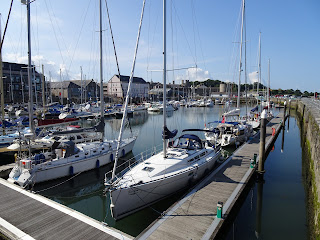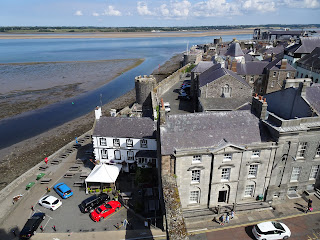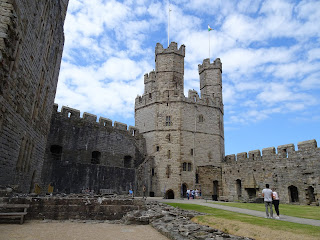Perhaps we should have just gone back to Llanberis yesterday and
taken the train to the top, risking the cloud, but we didn’t and I suspect we
will never stand at the top of Wales’ highest peak after all. However we
managed to fill our few days around Caernarfon very well, and could have easily
filled a few more.
 Most of our last day was spent in Caernarfon, checking out the
town, the quay and of course the castle which dominates the entire scene. We
chose to park down on the quay, a more expensive option than parking up near
that unacceptable Laundromat, but we were not to know how long we would need.
Most of our last day was spent in Caernarfon, checking out the
town, the quay and of course the castle which dominates the entire scene. We
chose to park down on the quay, a more expensive option than parking up near
that unacceptable Laundromat, but we were not to know how long we would need. Initially we set off around the quay, to the mouth of the River
Seiont and the Meanai Strait, the tide very low, the scene more of boats
sitting high and dry on their keels. Continuing along the Promenade, we arrived
at the Victoria Dock, a square tub full of classier and larger boats than those
moored rather unceremoniously in the river. Here the dock is like that we saw
at Aberaeron, except that at Caernarfon is far more salubrious.
Initially we set off around the quay, to the mouth of the River
Seiont and the Meanai Strait, the tide very low, the scene more of boats
sitting high and dry on their keels. Continuing along the Promenade, we arrived
at the Victoria Dock, a square tub full of classier and larger boats than those
moored rather unceremoniously in the river. Here the dock is like that we saw
at Aberaeron, except that at Caernarfon is far more salubrious.
After lingering about here, we headed up into the Old Town within
the outer castle walls. It is a strange sort of town, jazzed up by bunting,
perhaps left over from the royal wedding or the World Cup, and the tourists who
drifted into the centre over the course of the morning, but the retail services
seemed rather scant. I guess I was expecting to see more boutiques and chain
stores; of these there are few, however it does only have a population of less
than ten thousand folk.
 After calling into the bank and the post office to deal with a few
practical matters, we made our way to the castle and flashed our English
Heritage membership cards; goodness, how glad I am that we are members!
After calling into the bank and the post office to deal with a few
practical matters, we made our way to the castle and flashed our English
Heritage membership cards; goodness, how glad I am that we are members! Edward I’s castle is impressive, both for its size and its
location, with views over the water and back up toward Snowdonia. It has nine
foot thick multi-coloured walls and 150 foot high towers, of which there are
ten, and most of them fully accessible to the public . I say “accessible” with
no consideration for those less able than ourselves; the stairs are steep and
narrow and by the time you have navigated most of the towers, not wanting to
miss one possible view, hips and knees might be reminding one they are not as
young as they used to be.
Edward I’s castle is impressive, both for its size and its
location, with views over the water and back up toward Snowdonia. It has nine
foot thick multi-coloured walls and 150 foot high towers, of which there are
ten, and most of them fully accessible to the public . I say “accessible” with
no consideration for those less able than ourselves; the stairs are steep and
narrow and by the time you have navigated most of the towers, not wanting to
miss one possible view, hips and knees might be reminding one they are not as
young as they used to be.
There are a couple of films which are helpful in explaining the
castle’s genesis and battle history, and a few exhibitions about the
investitures and the legend behind the history of princes of Wales and how
these were used to woo the gullible to the idea of “foreign” princes; “foreign”
being anyone not Welsh. The interpretation panels are not as numerous and
detailed as I like to see, but then when one is concentrating on climbing up
and down, perhaps one doesn’t want to be too confused with information.

 Edward II was fortuitously born in the castle in 1284, less than a
year after Edward I had conquered the region, and was thereafter known as
Edward of Caernarfon, the first English Prince of Wales. Nearly seven hundred
years later in 1969, Prince Charles was invested with the same title in a
theatrical ceremony here at the castle, an event for which he prepared himself
studiously to the learning of the Welsh language. Well done, Charlie; it’s a
language that baffles me even to the extent that I can’t get my head around the
way to even say “Thank you” in the lingo, and I have been trying.
Edward II was fortuitously born in the castle in 1284, less than a
year after Edward I had conquered the region, and was thereafter known as
Edward of Caernarfon, the first English Prince of Wales. Nearly seven hundred
years later in 1969, Prince Charles was invested with the same title in a
theatrical ceremony here at the castle, an event for which he prepared himself
studiously to the learning of the Welsh language. Well done, Charlie; it’s a
language that baffles me even to the extent that I can’t get my head around the
way to even say “Thank you” in the lingo, and I have been trying.
Interestingly the castle is still owned by the Queen, even though
it is in the care of CADW. Perhaps this is another reason much about the castle
is spartan; she is not one to splash money about, so they say.
 Since 1986 Caernarfon’s castle and town walls have formed part of
a UNESCO World Heritage Site: “Castles and Town Walls of King Edward in
Gwynedd”. Others under this umbrella are that at Beaumaris which we visited
three years ago, Harlech which we have already passed and missed and Conwy
which we will probably call into within the next two weeks.
Since 1986 Caernarfon’s castle and town walls have formed part of
a UNESCO World Heritage Site: “Castles and Town Walls of King Edward in
Gwynedd”. Others under this umbrella are that at Beaumaris which we visited
three years ago, Harlech which we have already passed and missed and Conwy
which we will probably call into within the next two weeks.
We lunched down on the quay then set off to the Morrison’s
superstore to shop for provisions and fuel in preparation of our departure this
morning, then back at camp, Chris fiddled unsuccessfully with the heater which
is falling to bits as we rattle and roll around the country. He has decided
that we will have to call for professional assistance, but in the meantime, it
will ride strapped up between destinations.
This morning we woke to rain, good steady farmer-pleasing rain,
but not so pleasing for those breaking camp. I kept my own outdoor contributions
to a minimum; there seemed little point in us both getting soaked to the skin.
As we pulled out, we met our host, John, busy with one of the many facets of
his enterprise. He assured us he would not forget us quickly; my pseudo-Welsh
name would help there. We assured him that should we be back this way, we would
surely close Cil-y-Bont over any others in the area.
We joined the A487 just north of Caernarfon, soon joining the A55
heading east along the coast. This dual carriageway hugs the shore closely,
often passing through the steep and rugged hills that come right down to the
coast via a series of tunnels. Another tunnel took us under the River Conwy,
and as we passed along this road between the shoreline and the mass of houses,
we felt we had emerged from the rural Wales we had come to know so well.
Our journey was little more than fifty miles today, as have so
many of our recent transfers. We were keen to find a spot to pull off and park
up for an hour or so, but never more than two hours if it was a service centre
(we have learned the hard way that this is a costly business). I had spotted
three large “S” symbols on the map and the first of these was near Penmaenmawr.
We turned off the highway up into the hill, with no sight of any service
centre. We continued on up into the compact streets of the town looking for
somewhere to turn. Alas the streets all showed up on our Tomtom as dead ends;
it was a small miracle that The Chauffeur was able to back around into one of
these before returning to our default setting.
Now averse to relying on the map symbols, we looked for a “Parking”
along the roadside, finding a space unclogged by trucks and settled down to
read until lunchtime. We were so close to the busy road that the caravan rocked
and rolled every time a vehicle passed; sitting on our own loo was an
experience all by itself. Just less than a mile on we passed another service
centre that had been marked similarly on our map; this one looked far more
promising and we could have enjoyed a far more peaceful break.
It was here in the vicinity of Abergele that the road turned
south, away from the shore, and crossing through rural countryside that seemed
so much more English than that viewed over the past few weeks. Our destination
was just off the A55, the directions easy to follow, however they did not take
into account that to continue along the A55, one needs to “turn off” otherwise one finds oneself heading toward the
Wirral on the A494, as we did.
This was not our only mistake; the next was to pull into the wrong
camping ground, an incredibly stupid one because we were booked into this Caravan
& Motorhome Club certified location not a Caravan & Camping Club
certified site. It seems this is a common mistake because the hostess of this
soon put us right and in response to our profuse apologies, told us this was
so.
I have to say I was relieved that our camp was this second one up
the road, rather than the first; our first impressions have been very good. Fortunately
the rain stayed until after we were set up, but has since set in once more. Our
hosts who milk about one hundred and twenty cows on their two hundred or so
acres will be very happy with the rain.
No comments:
Post a Comment